“We went to the moon to have fun, but the moon turned out to completely suck.” — M.T. Anderson, Feed
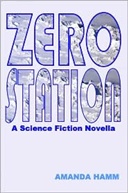 |
Zero Station, by Amanda Hamm I mistakenly downloaded this to read on my Nook. Billed as a novella, it isn’t even a short story … more like a pitch for a story idea. A good idea, too, but only a sketch, with no characterization, no background, none of the detail that makes a story interesting. Frankly, I’m surprised Ms Hamm found someone to publish it in present form … ah, now I understand: it’s self-published. That’s what happens if you aren’t careful with e-book downloads! |
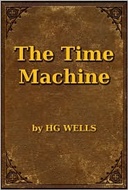 |
The Time Machine, by H. G. Wells The great classic, pretty much as remembered from my teenage years, only more suspenseful. Today we cringe at Wells’ interest in eugenics (in The Time Machine, present-day privileged classes evolve into a useless, pampered above-ground race while workers evolve into a brutal hairy underground life form). But those were the times Wells lived in, and his story remains masterful and timeless. Isn’t it about time someone made a movie of it again? |
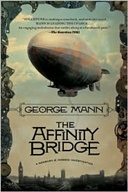 |
The Affinity Bridge, by George Mann The blurb on the cover calls it “steampunk.” “Cashing in on steampunk” is more like it. The last sci-fi/steampunk novel I read was The Difference Engine by Bruce Sterling & William Gibson (reviewed here). I thought it an unexciting story, but at least the present-day steam-driven London of the story was well explained. You understood why, in the writers’ conceit, England and other industrialized nations relied on steam power to a much larger degree than actually happened in reality (the Pope’s opposition to internal combustion), and the engineering and science were plausible … if, going into the 20th century, we had been denied the internal combustion engine, the world Sterling & Gibson conjure up would have been the logical result. George Mann’s vision in The Affinity Bridge is slightly different. The time is Victorian England, somewhere in the late 1800s. Steam rules, but has been developed to a far greater extent than happened in reality. But in Mann’s story, there is no rigor, no logic, no coherence. The science & engineering don’t make a lick of sense and aren’t even remotely plausible. Steam-powered trams, airships, and clockwork robots are a mere backdrop to a third-rate Sherlock Holmes knockoff. Gentlemen with pipes, brandy snifters, and laudanum habits. A daring woman who doesn’t mind getting the hems of her floor-length skirt dirty. Evil villains. Even zombies. A more charitable person would describe The Affinity Bridge as dime store hugger-mugger. I call it what it is: a load of crap. |
 |
Stories, edited by Neil Gaiman & Al Sarrantonio This is an anthology of science fiction, fantasy, and horror stories by contemporary authors, including one story each by the collection’s editors, Neil Gaiman and Al Sarrantonio. I don’t read many short story collections, but every time I do I think to myself that I should do it more often. This anthology was consistently good, with nearly every story a winner. And I must say it made me want to read more by both Neil Gaiman and Al Sarrantonio, two authors I’ve heard plenty about but whose work I hadn’t, until now, read. |
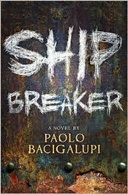 |
Ship Breaker, by Paolo Bacigalupi Ship Breaker is killer good: a young adult adventure set in a post-nation/state world of environmental collapse, a world where powerful clans control sail- and dirigible-driven trade, a world where society is divided into two classes: the very rich and the very poor. It’s a Margaret Atwood scenario on steroids, and like Atwood, Bacigalupi has rich narrative and descriptive powers: you can see the world of the shipbreakers on their oil-stained beach, you can feel the rust and sharp edges on the steel plates the breakers pry off the beached oil tankers, you can hear the hammer blows and the pop of forced rivets, you can smell the fuel oil and sweat. There’s nothing theoretical about Bacigalupi’s writing, nothing that requires page after page of dry explanation; his fictional world is immediate and gripping, fully revealed through the context of a kick-ass story, all but real. Honestly, it’s hard these days to distinguish “young adult” from “adult” fiction. As a general rule (and I’m sure there are exceptions), in YA fiction the boy and girl protagonists don’t quite consummate their budding sexual relationship or get all messed up with alcohol and drugs, aspects of adult writing that often get in the way of a good story. I’d put Ship Breaker up against any harrowing adult sci-fi/adventure/thriller I’ve read in the past several years. I’ll be looking out for the second volume of this great series. |
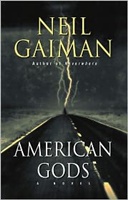 |
American Gods, by Neil Gaiman See, I told you I was going to read some Neil Gaiman. I prefer hard science fiction, but have to admit I quite liked this fantasy novel. Gaiman’s conceit is that the early people who came to the New World brought along their hearth and home gods, who thrived here until they were gradually forgotten. Ancient Siberian earth and bison gods came with the people who migrated over the land bridge from Russia to Alaska, Odin sailed over with the Vikings, leprechauns and banshees booked passage with the Irish in steerage, and so on. In the novel, a rootless young man becomes part of a plot by Odin and other nearly-forgotten gods to reassert themselves. Sounds silly, but it’s a very readable novel with enough suspense in the plot to keep you turning pages, and ultimately far more rewarding than anything in, say, the Harry Potter series. Neil Gaiman writes like Gene Wolfe when he’s on a roll; he’s engaging and interesting and I will add him to my list of favorite authors. |
 |
Feed, by M. T. Anderson Once again, I prove to myself that young adult science fiction might as well scrap the YA label. Adult readers will find in Feed an engaging, satisfying, well-written near-future dystopian novel with two strong teenage characters, Titus and Violet. The “feed” of the title is an implanted internet/smart phone connection used by almost everyone. People can message one another, share what they are seeing, tasting, smelling, touching, and hearing, and instantly access information on any topic. Which sounds good until you realize that it’s all controlled by corporations, which use the feed to simultaneously control the flow of information and lull the population into consumerism and conformity — a fact well known and actively resisted by Violet, who attempts to educate Titus, a happy consumer with a certain amount of native intelligence. The world of Feed is a world falling apart, pushed to the limit by resource depletion, pollution, and overpopulation: imagine Brave New World rewritten by Margaret Atwood. Good stuff, and I want more. |